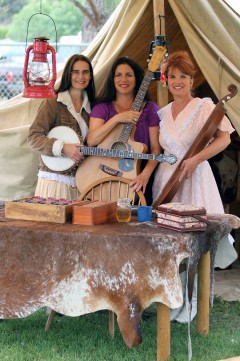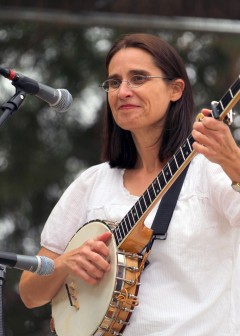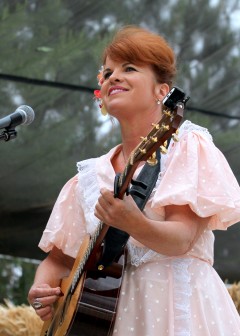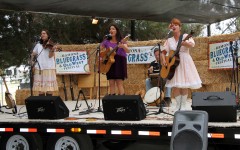Cover Story
Common Threads: The Lacemakers

The Lacemakers (left to right): Kim Donaldson, Heloise Love, Miss Darla. Photo by Dennis Andersen.

Heloise Love. Photo by Dennis Andersen.

Kim Donaldson. Photo by Dennis Andersen.

Miss Darla. Photo by Dennis Andersen.

Trio at the Ramona Bluegrass Festival last month. Photo by Dennis Andersen.
Meet the Lacemakers, three women, all multi-instrumentalists with lovely voices, who also just happen to be a hair stylist, a teacher, and a natural dog treat company owner. The trio, based out of Escondido, specializes in Scottish, Irish, Appalachian, bluegrass, and original mountain music. Among them they play guitars, fiddle, banjo, drum, pennywhistle, and mountain and hammered dulcimers. The group’s founder, Heloise Love, who plays acoustic guitar, pennywhistle, and Celtic drum, formed the Lacemakers in 2011. Originally named the Heloise Love Band, a group decision was made to morph into their current Lacemakers moniker. “I never wanted to go with the Heloise Love Band, even though it was more recognizable in the Celtic genre due to my history as a founding member of the Scottish band, Highland Way,” Love explained. “I eventually put my foot down as I did not want to be the leader. The Lacemakers made more sense because we reflect the music derived from Ireland and Scotland, and are akin to the women who cooked, raised children, crafted, took care of their families, and still managed to create lace and song long ago,” she concluded.
The group became a reality when Miss Darla, who plays guitar, mandolin, and mountain dulcimer in the band, crossed paths with Love at one of her gigs. “I met Heloise when she was with Highland Way.” she recalled. “Years later, after she left Highland Way, our paths crossed again, and we formed the Mountain Mommas together, a group that blended Scottish, Irish, mountain/folk, contemporary, and original music “ Shortly afterward, the Lacemakers became a trio when Darla met Kim Donaldson at a jam session, consequently inviting her to sit in with the Mountain Mommas. The connection seemed instant and the trio took off from there. Donaldson, plays fiddle and banjo in the Lacemakers, and is responsible for many of the group’s musical arrangements.
The group boasts around two hundred songs in their vast repertoire, including a mixture of Irish, bluegrass, and folk music standards, along with an expansive repertoire of original tunes, contributed by all three women. The trio recently released their second CD, Common Thread, a follow up to their self-titled debut disc last summer; both discs feature their strong and well devised vocal harmonies. The 13-track CD, bolstered by veteran local musicians Tim Butler on bass and Chris Clarke on mandolin, contains all original tunes, aside from a traditional tune, “Billy in the Low Ground,” placed in a medley with Donaldson’s tune, “Devil’s Box.” Many of the eight tunes that Donaldson penned for Common Thread, relate stories of her days growing up in Northern California, including “Cannery Row,” which evokes memories about the infamous landmark along Monterey Bay. “I use to play on the falling-apart pilings when I was a kid,” she stated “There was no aquarium or industry there at that time. My brother and I use to go fishing through the holes in the foundations of the old canneries.” Another tune, “Macramé,” tells about growing up and going to her grandmother’s house in Cachagua, Carmel Valley. “My grandfather was the keeper of the Los Padres Dam. He used to take me on the morning readings in his truck. I loved it because I would bounce all over as he drove up and down the hills,” she reminisced. “ ‘Devil’s Box’ is about my great uncle, Samson Babbs, who eight generations ago, married into the Quaker faith but wouldn’t give up playing his fiddle. The annals of the monthly meetings for the Society of Friends lists, in 1767, that Samson Babbs was put out for ‘keeping and playing a fiddle.’”
Love penned two of the tunes on Common Thread — “Cautionary Tale,” and “Carol’s Song” — the former being self descriptive, in Love’s words: “an older woman warning a younger folk to think hard before you make big life decisions.” The latter, about her favorite cousin, as she explained: “One of the best people I have ever met; she worked at Disneyland her entire career, a beloved employee. She died suddenly from a simple operation gone bad last year, an unexpected blood infection… so sudden a death that I did not get a chance to say goodbye, so I wrote that song in her memory.”
Darla contributed three tunes to Common Thread, including “I Am of Ireland,” written from an Irish immigrant woman’s perspective, making life changes for the better, while still missing her native homeland. “Ten Years Time,” describing the all too common case of missed opportunities of connecting one on one, and ”Georgia Line,” as Darla puts it: “written on my back porch while daydreaming about leaving San Diego and taking a different path in life.”
Even though the Lacemakers sound has Irish and Scottish roots, their folk-tinged compositions combined with their mellifluous three-part harmony, places them in more of a pop idiom. “We’re really not traditional Irish or Scottish musicians,” Love stated, as I joined the Lacemakers for a coffee confab at a local Starbucks on the other side of the tracks in Escondido. “We’re more Americana,” she continued. “Yes, folk or Americana fits us as a better label,” Darla added. “We have so many different influences.” Donaldson concluded the topic with a distinctive observation, “We have a five-string bluegrass banjo, which sets us apart from traditional Celtic instrumentation, and we’re not trying to be traditional Irish. We’re analogous to what Alison Krauss did for bluegrass when she incorporated her Americana/pop sound, utilizing bluegrass instruments. All in all we’re a bunch of mutts, so we do a little bit from a lot of different styles.”
The Lacemakers not only play locally in the Southern California area, but travel to play shows at many of the national Celtic festivals, primarily because of Love’s reputation with Highland Way, in addition to Darla’s Irish connections and Donaldson’s bluegrass contacts. “They kind of remember us from other bands,” Love said, “and we’re persistent and do everything right. We show up early and present our show according to what we say we’re going to do,” she concluded. “We have a lot of fun and I think it shows,” Darla added, “and it’s also our time to do this; we all have grown children and more flexibility now to travel to shows if we need to.”
As much as these festivals highlight some of the best acts around the Celtic scene, they also feature some of the younger musicians that have hopped on board with their own interpretations of Irish-based music. “The problem nowadays is that they have lost the folk element, and instead the festivals are often showcasing four guys with guitars and a fiddle, calling themselves a Celtic rock band,” Love emphasized. “These groups tend to have more pull because they can bring in younger audiences, particularly if they have an English accent and coax people to drink more as well.” Darla added her perspective from her Irish dance background, “I had to tell many who knew me in the traditional Irish community as a dancer that I was going to be playing music with the Lacemakers, and not dancing. Many of the traditionalists are not ready for the crossover movement; they want flair,” she emphasized.
Although the Lacemakers were influenced by a number of Irish and Scottish music luminaries, including the Chieftans, Dougie MacLean, and Alex Beaton, they have also been inspired by local musicians as well, one in particular: the late Brian Baynes. “Brian was somebody I really admired,” Love was quick to state. “He brought many highly regarded Irish musicians to his house to record. Such a laid back performer when I played with him on a few occasions, a very positive influence on me.” As far as the recent explosion of Celtic-oriented productions, fueled by many of the omnipresent PBS specials, including Riverdance, Celtic Thunder, and Celtic Woman, the popularity and visibility of Irish music and dance has come to the forefront, which presents somewhat of a double-edged sword. “I think those productions are stunningly beautiful, well choreographed, along with great singing, but they don’t play instruments, other than the one featured violinist,” Love exclaimed. “Sort of like a modern day Lawrence Welk show,” Darla added, “although we do owe them a debt of gratitude for bringing Celtic music to the forefront.” Donaldson took another angle on the subject. “A lot of these productions, including some of the bluegrass extravaganzas, are inspiring,” she said. “Makes you want to take your own playing to higher levels and learn some new ideas on your instrument.”
To fully appreciate this unique musical aggregation, it is paramount to reflect on each of the three ladies’ individual musical evolution. Darla started performing as an Irish step-dancer with the band Kitchen Fire back in the late ’90s.”I occasionally got to sing a couple of harmony parts with the band aside from my dancing,” she said. “I enjoyed the musical process so much, that I decided to form my own group, Sheela-na-Gig, an all-girl band, performing mostly Irish music and some originals. As a child I would tinker on my dad’s guitar and banjo when he wasn’t looking and was always fascinated with the songs I could recreate by ear on them,” Darla recalls. “However, after several years of playing the guitar, I purchased a mandolin as a result of listening to Bill Monroe. Although a smaller instrument, it didn’t necessarily translate as being easier to play, as I soon found out… but I still loved the challenge. The mountain dulcimer,” she continued, “came into my life as a result of a work break at my hair salon, when in between clients, I would regularly walk down to the Acoustic Expressions music store on University Ave. (formerly the New Expression and House of Strings music shop), and tinker with the instruments in the used section of the store. The minute I took my first strum on a mountain dulcimer, I fell in love with it and truly felt a deep connection to that instrument in a way that was inexplicable.”
Darla’s affinity for roots music can be traced back quite a few generations in her family tree. “From radio, to records, to live jams in the living room, and on the front porch playing music, dancing, and singing had always been a way of life and a way to pass the time,” she exclaimed. “My dad’s side of the family is rather large and the more musical side of my family, spanning over three hundred years of survival in the Appalachians. My grandfather, when not moonshinin’, made his own banjos and picked in the claw-hammer style. Like so many of the baby boomer generation, those four lads from Liverpool were also a huge influence for Darla as were the usual suspects within the bluegrass circles. I’ve never had any formal voice lessons, but have always had a passion for songs. Aside from bluegrass music, it was truly the Beatles that formulated my keen sense of love for harmonies and the creative process of music,” she said. “I would listen to and break down each vocal and instrumental part, a process that was fun and provided excellent ear training.” Darla was born in Virginia, a descendant of a long line of moonshiners in the Appalachians. “When my father joined the Navy, that enabled our family to travel and experience different parts of the country, California in particular. I was raised on bluegrass and old school country music, listening to Flatt and Scruggs, the Osborne Brothers, Bill Monroe, the Stanley Brothers, Johnny Cash, and Loretta Lynn. Irish music, especially in the traditional sense, took over when I became involved in Irish step-dancing,” she recalled. “Although I have had the privilege, over the years, to have taken a few lessons from the likes of local musicians Shawn Rohlf, Vickie Cottle, Walt Richards, and Wayne Riker,” she mused, “I am basically a self-taught organic musician,” Darla writes a majority of the group’s tunes and sees that as a joy, but a challenge as well. “I really enjoy writing music and songs that are inspired by someone or something… there’s just so much to write about. Just look around, or look within, as sometimes writing can be very therapeutic.”
Donaldson’s musical journey started early when her mom insisted that all of her six children take piano lessons. “All the while there was mostly folk music playing, usually the Brothers Four, Simon and Garfunkel, the Kingston Trio, and Peter, Paul and Mary. My oldest sister would play piano, and we’d all gather around, singing for hours at a time,” she remembered. “I initially played the violin in the elementary school orchestra, but it wasn’t until my thirties that I picked it up again and took lessons for a few years; that’s when I met the bluegrass band, the Ash Street Ramblers, who quickly “unlearned me.” I remember going for the first time to jam with them and asking if they had any music; their response was, ‘you mean those papers with dots?’” Upon playing her first gig with them, she told the band leader not to give her any solos, however, that request was ignored and she got called out to do a break on every tune. “It was surreal, until they slipped a hundred dollar bill in my pocket… that’s when I knew that I could get used to this type of gig scene.” Donaldson’s love of Celtic and roots music was acquired early on in a parallel universe with country music. “I have always loved old time music. As a teen I listened to the hillbilly radio station, KFAT, out of Gilroy, California, a station that played Emmylou Harris, Willie Nelson, Waylon Jennings, and the like… couldn’t get enough of it, along with Celtic, old time, and bluegrass music. they all have similar beginnings — tunes that come from the old country when immigrants came over from Scotland and Ireland and settled in the Appalachians and made the old music their own. Once that music made its way down the mountain,” she continued, “and Bill Monroe and others gave it a face lift, it became bluegrass.” Donaldson still plays on occasion with other musical outfits in keeping her fiddling skills sharp. “I play with the California State Old Time Fiddlers when I can and still play with the Ash Street Ramblers. They are like my family, as we get together without fail every Tuesday evening and play for hours. Music has brought a lot of great friends my way as well.”
Love was fortunate to have music abounding while growing up in her Point Loma home. “We had everything from Zorba the Greek to Herb Alpert, to the Irish Rovers on our stereo system,” she recalled. “My two sisters played guitar, auto harp, and clarinet, and we often sang three part harmonies. I started playing the coronet at age eight, until my dad bought me a trumpet, and I continued to play in school bands through my first year of college.” Akin to the other two Lacemakers, Love’s exposure and interest for old time music was peaked early on, in addition to the omnipresent folk and pop music of the day. “I always had an interest in old time music, including bluegrass and Celtic, particularly the folk music from England, Ireland, and Scotland.
However, in my teen years, I loved all the usual rockers of the ’70s and ’80s, aka Fleetwood Mac,” she stated. “In my thirties is when I discovered how much I loved the pipes and became heavily influenced by many of the greats in Scottish balladry, especially Alex Beaton, Aladair Fraser’s fiddling, Ed Miller, and Eric
Rigler.” Love has been fortunate to have appeared on stage with many of the greats in the Celtic music genre, including Beaton, Miller, the Wicked Tinkers, and Brian Baynes,
In the late ’90s, Love joined Bow Willow, a vocal trio fronted by San Diego folk luminary, Walt Richards and guitarist, Paula Strong, a year venture that Love reflected back on. “They were a bit more on the old timey music end, with many train song themes as well. At that point in time my heart was beginning to just long for Celtic material. It was a great experience and I remain grateful to Walt and Paula and love them dearly.”
As far as being an all female group in a somewhat traditional male-dominated genre, the Lacemakers haven’t encountered any overt issues at their gigs and festivals, although Donaldson was quick to point out one subtlety: “we’re often playing on a more demure stage, but sometimes I wish we were situated on a more visible rockin’ stage.”
Darla agreed, but added, “However, we’re seasoned players that exhibit high energy and a content stage presence, so whatever stage we’re on, we’re gonna have a good time no matter what.”
All three ladies agreed upon reflecting back on one of their more memorable gigs, a show at the Irish Festival at the L.A County Fairgrounds a couple of years back. “It was fabulous, we had a big crowd, everybody loved us, and we sold a ton of CDs,” Love emoted.
As the music business would have it, sure enough the following year at the same annual festival, the opposite occurred as Darla recalled: “They put us in a tea garden, off in the lower 40, no CD sales and playing to two 80-year-olds.”
The Lacemakers have made a joint commitment in continuing on their path of playing gigs, recording CDs, composing their unique brand of tunes, and above all, having fun, a statement that this author can confirm, as the trio genuinely gets along well and works together as a harmonious unit on and off the stage. Donaldson said it best in closing: “one day at a time, go with the gusto, take it as far as we can and as long as we can, and not think too much about yesterday or tomorrow.”
See the Lacemakers at Wynola Pizza Express on Friday, June 21, 6pm.
The Lacemakers’ CD is reviewed this month.





